Strategic Human Resource Project: BMO HR Practices Report
VerifiedAdded on 2023/01/19
|12
|3484
|52
Report
AI Summary
This report provides a detailed analysis of strategic human resource practices at the Bank of Montreal (BMO). It begins with an introduction to strategic HRM and its importance in achieving organizational goals. The report then delves into key HR functions, including talent selection, examining BMO's methods for identifying organizational goals, sourcing talent, recruitment, and employee retention. It then analyzes employee performance management using methods like Management by Objectives, 360-degree feedback, and annual performance reviews. Further, the report explores BMO's approach to employee training, including on-the-job training and bank-wide student programs, and the importance of fostering transparency and setting clear objectives. The report also examines employee compensation, pay structures, and the significance of employee competence and government regulations. Finally, it focuses on employee learning and development, including personal and professional training, and employee engagement strategies. The report concludes with recommendations for BMO to enhance its agile talent practices and improve overall HR effectiveness.
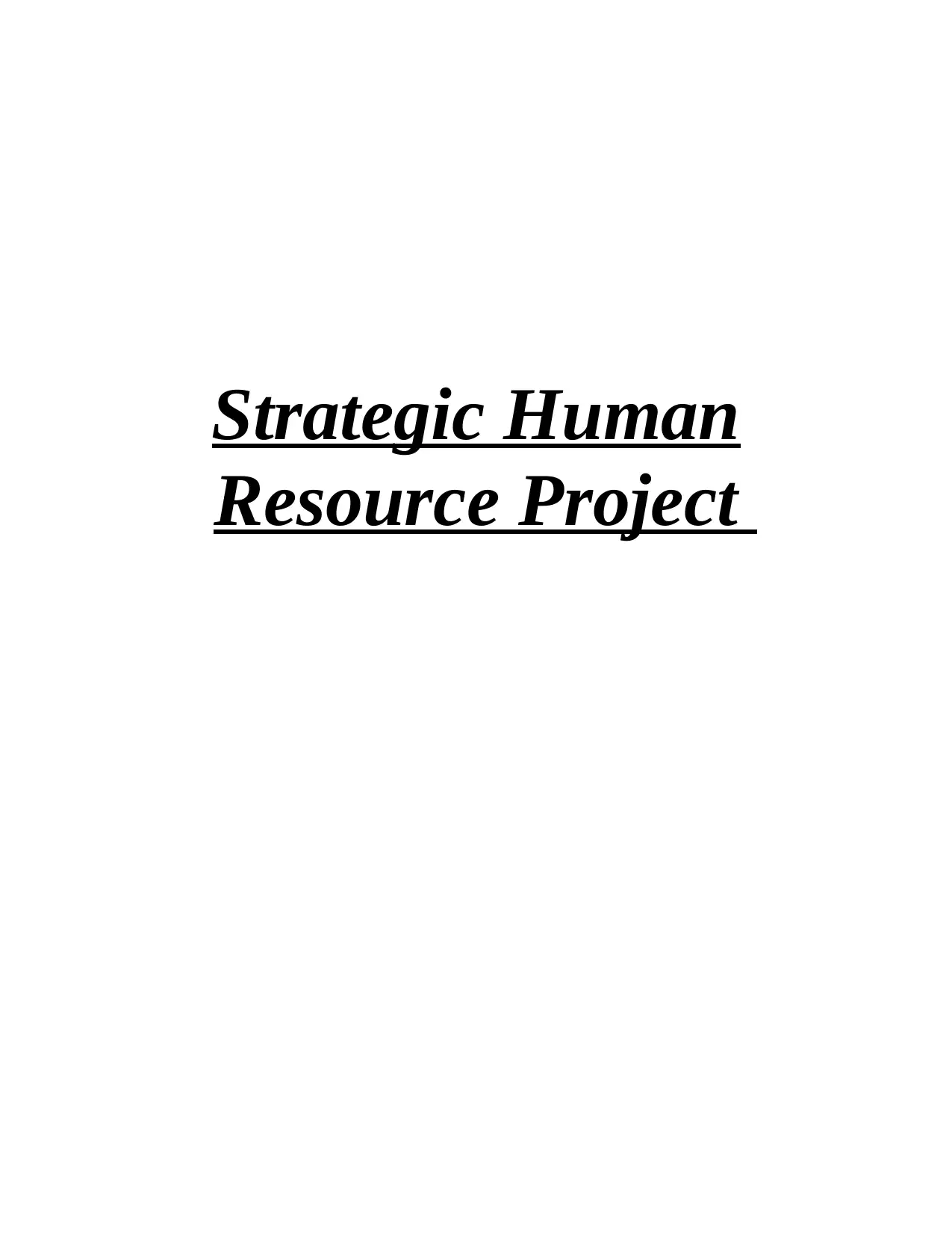
Strategic Human
Resource Project
Resource Project
Paraphrase This Document
Need a fresh take? Get an instant paraphrase of this document with our AI Paraphraser
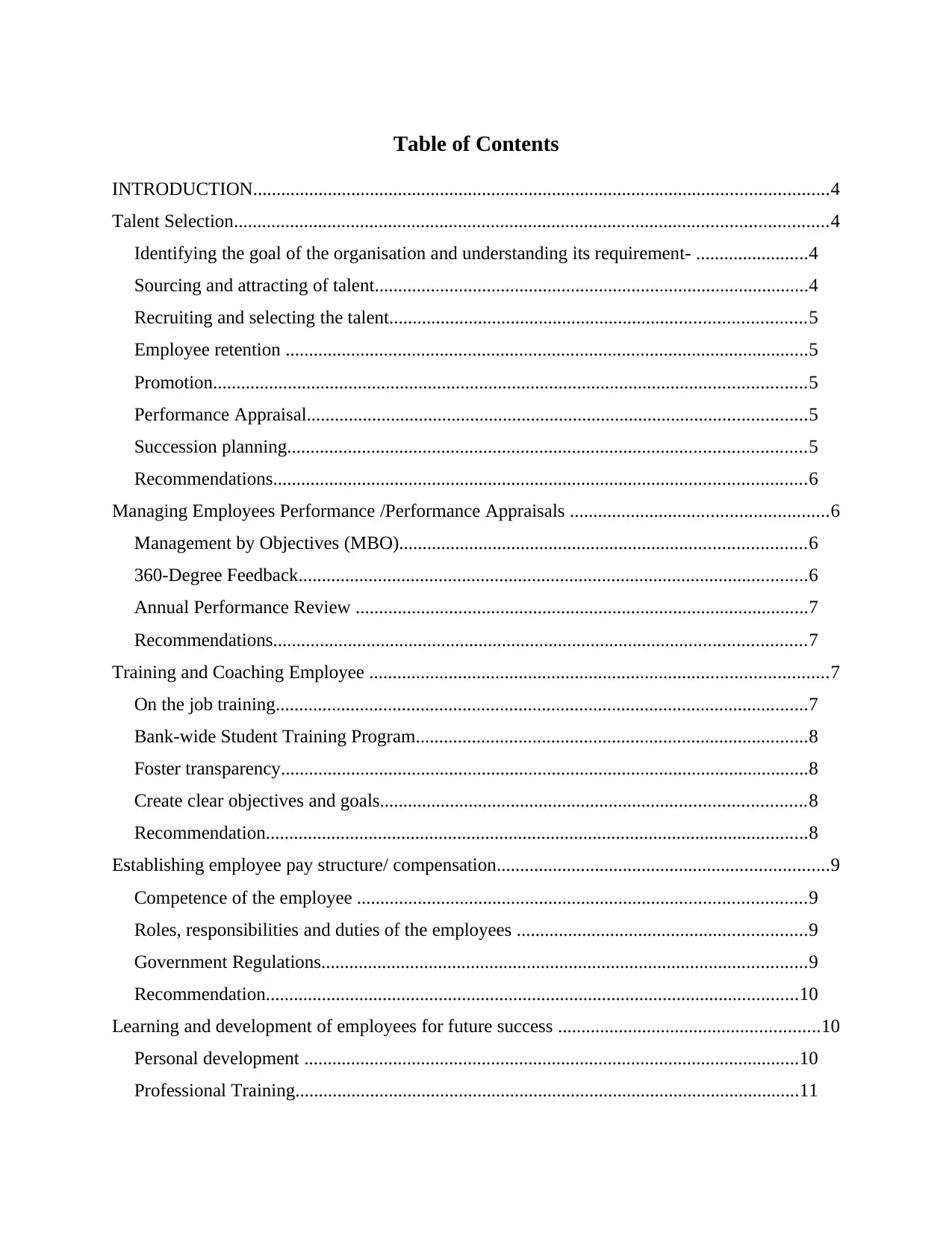
Table of Contents
INTRODUCTION...........................................................................................................................4
Talent Selection...............................................................................................................................4
Identifying the goal of the organisation and understanding its requirement- ........................4
Sourcing and attracting of talent.............................................................................................4
Recruiting and selecting the talent.........................................................................................5
Employee retention ................................................................................................................5
Promotion...............................................................................................................................5
Performance Appraisal...........................................................................................................5
Succession planning...............................................................................................................5
Recommendations..................................................................................................................6
Managing Employees Performance /Performance Appraisals .......................................................6
Management by Objectives (MBO).......................................................................................6
360-Degree Feedback.............................................................................................................6
Annual Performance Review .................................................................................................7
Recommendations..................................................................................................................7
Training and Coaching Employee ..................................................................................................7
On the job training..................................................................................................................7
Bank-wide Student Training Program....................................................................................8
Foster transparency.................................................................................................................8
Create clear objectives and goals...........................................................................................8
Recommendation....................................................................................................................8
Establishing employee pay structure/ compensation.......................................................................9
Competence of the employee ................................................................................................9
Roles, responsibilities and duties of the employees ..............................................................9
Government Regulations........................................................................................................9
Recommendation..................................................................................................................10
Learning and development of employees for future success ........................................................10
Personal development ..........................................................................................................10
Professional Training............................................................................................................11
INTRODUCTION...........................................................................................................................4
Talent Selection...............................................................................................................................4
Identifying the goal of the organisation and understanding its requirement- ........................4
Sourcing and attracting of talent.............................................................................................4
Recruiting and selecting the talent.........................................................................................5
Employee retention ................................................................................................................5
Promotion...............................................................................................................................5
Performance Appraisal...........................................................................................................5
Succession planning...............................................................................................................5
Recommendations..................................................................................................................6
Managing Employees Performance /Performance Appraisals .......................................................6
Management by Objectives (MBO).......................................................................................6
360-Degree Feedback.............................................................................................................6
Annual Performance Review .................................................................................................7
Recommendations..................................................................................................................7
Training and Coaching Employee ..................................................................................................7
On the job training..................................................................................................................7
Bank-wide Student Training Program....................................................................................8
Foster transparency.................................................................................................................8
Create clear objectives and goals...........................................................................................8
Recommendation....................................................................................................................8
Establishing employee pay structure/ compensation.......................................................................9
Competence of the employee ................................................................................................9
Roles, responsibilities and duties of the employees ..............................................................9
Government Regulations........................................................................................................9
Recommendation..................................................................................................................10
Learning and development of employees for future success ........................................................10
Personal development ..........................................................................................................10
Professional Training............................................................................................................11
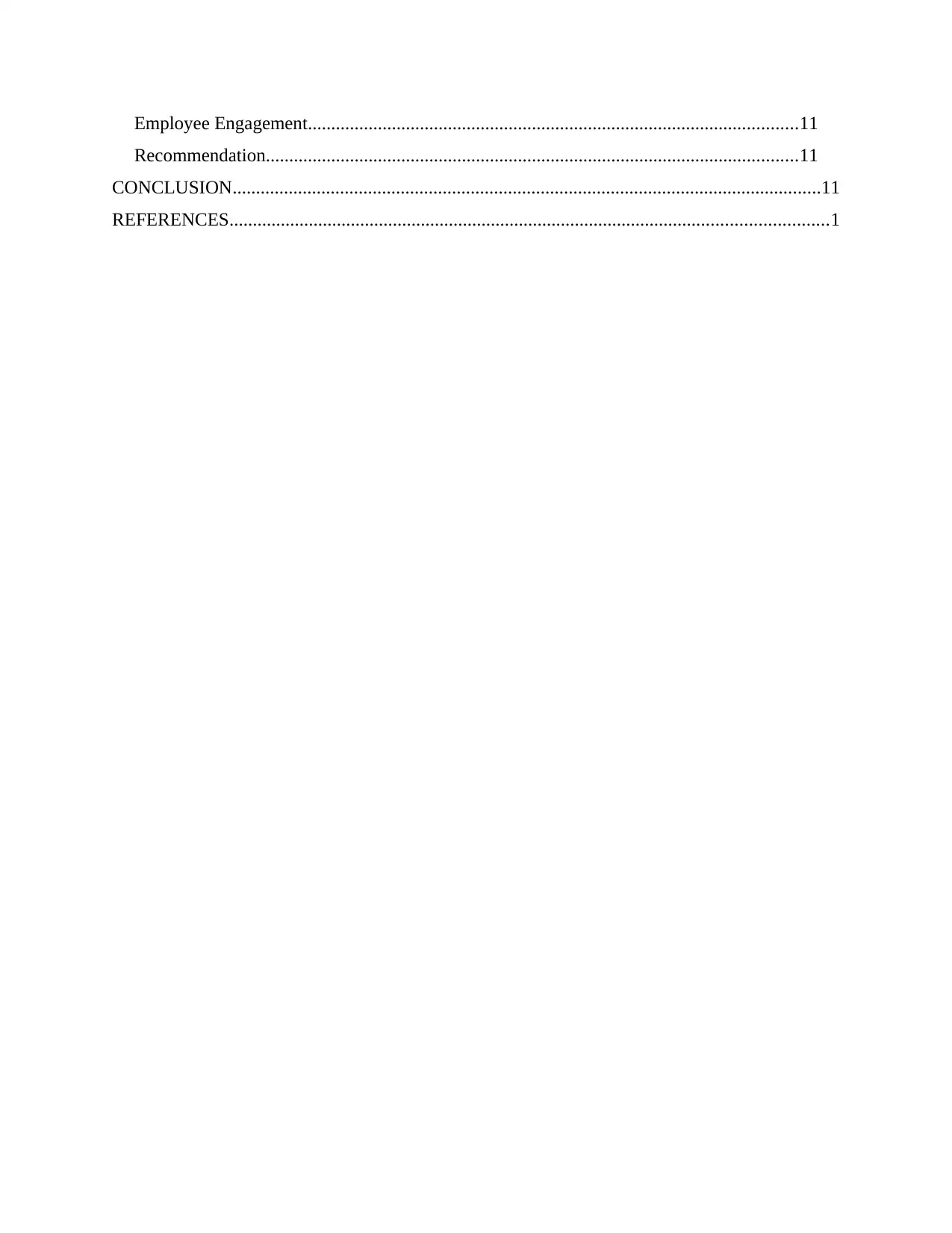
Employee Engagement.........................................................................................................11
Recommendation..................................................................................................................11
CONCLUSION..............................................................................................................................11
REFERENCES................................................................................................................................1
Recommendation..................................................................................................................11
CONCLUSION..............................................................................................................................11
REFERENCES................................................................................................................................1
⊘ This is a preview!⊘
Do you want full access?
Subscribe today to unlock all pages.

Trusted by 1+ million students worldwide
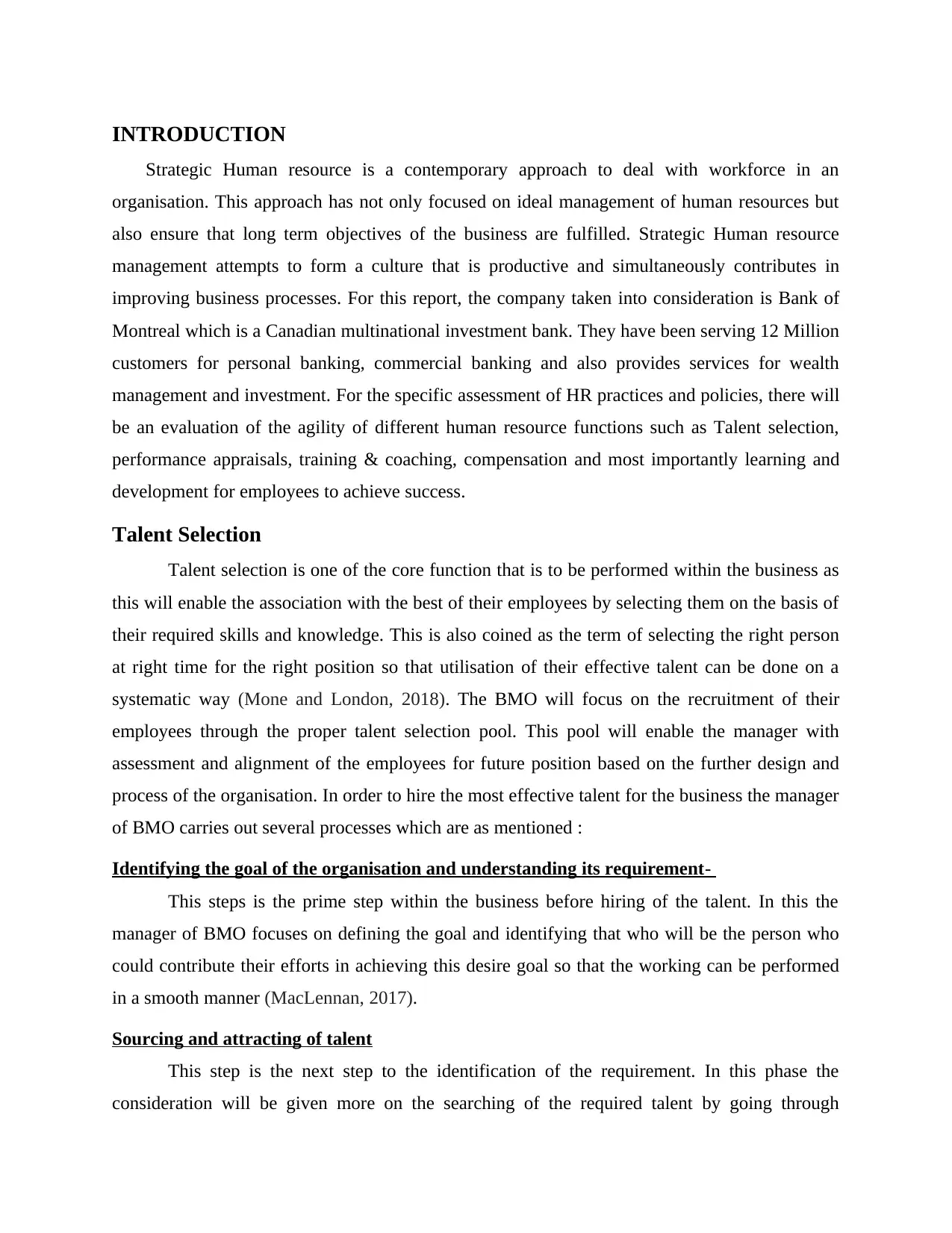
INTRODUCTION
Strategic Human resource is a contemporary approach to deal with workforce in an
organisation. This approach has not only focused on ideal management of human resources but
also ensure that long term objectives of the business are fulfilled. Strategic Human resource
management attempts to form a culture that is productive and simultaneously contributes in
improving business processes. For this report, the company taken into consideration is Bank of
Montreal which is a Canadian multinational investment bank. They have been serving 12 Million
customers for personal banking, commercial banking and also provides services for wealth
management and investment. For the specific assessment of HR practices and policies, there will
be an evaluation of the agility of different human resource functions such as Talent selection,
performance appraisals, training & coaching, compensation and most importantly learning and
development for employees to achieve success.
Talent Selection
Talent selection is one of the core function that is to be performed within the business as
this will enable the association with the best of their employees by selecting them on the basis of
their required skills and knowledge. This is also coined as the term of selecting the right person
at right time for the right position so that utilisation of their effective talent can be done on a
systematic way (Mone and London, 2018). The BMO will focus on the recruitment of their
employees through the proper talent selection pool. This pool will enable the manager with
assessment and alignment of the employees for future position based on the further design and
process of the organisation. In order to hire the most effective talent for the business the manager
of BMO carries out several processes which are as mentioned :
Identifying the goal of the organisation and understanding its requirement-
This steps is the prime step within the business before hiring of the talent. In this the
manager of BMO focuses on defining the goal and identifying that who will be the person who
could contribute their efforts in achieving this desire goal so that the working can be performed
in a smooth manner (MacLennan, 2017).
Sourcing and attracting of talent
This step is the next step to the identification of the requirement. In this phase the
consideration will be given more on the searching of the required talent by going through
Strategic Human resource is a contemporary approach to deal with workforce in an
organisation. This approach has not only focused on ideal management of human resources but
also ensure that long term objectives of the business are fulfilled. Strategic Human resource
management attempts to form a culture that is productive and simultaneously contributes in
improving business processes. For this report, the company taken into consideration is Bank of
Montreal which is a Canadian multinational investment bank. They have been serving 12 Million
customers for personal banking, commercial banking and also provides services for wealth
management and investment. For the specific assessment of HR practices and policies, there will
be an evaluation of the agility of different human resource functions such as Talent selection,
performance appraisals, training & coaching, compensation and most importantly learning and
development for employees to achieve success.
Talent Selection
Talent selection is one of the core function that is to be performed within the business as
this will enable the association with the best of their employees by selecting them on the basis of
their required skills and knowledge. This is also coined as the term of selecting the right person
at right time for the right position so that utilisation of their effective talent can be done on a
systematic way (Mone and London, 2018). The BMO will focus on the recruitment of their
employees through the proper talent selection pool. This pool will enable the manager with
assessment and alignment of the employees for future position based on the further design and
process of the organisation. In order to hire the most effective talent for the business the manager
of BMO carries out several processes which are as mentioned :
Identifying the goal of the organisation and understanding its requirement-
This steps is the prime step within the business before hiring of the talent. In this the
manager of BMO focuses on defining the goal and identifying that who will be the person who
could contribute their efforts in achieving this desire goal so that the working can be performed
in a smooth manner (MacLennan, 2017).
Sourcing and attracting of talent
This step is the next step to the identification of the requirement. In this phase the
consideration will be given more on the searching of the required talent by going through
Paraphrase This Document
Need a fresh take? Get an instant paraphrase of this document with our AI Paraphraser
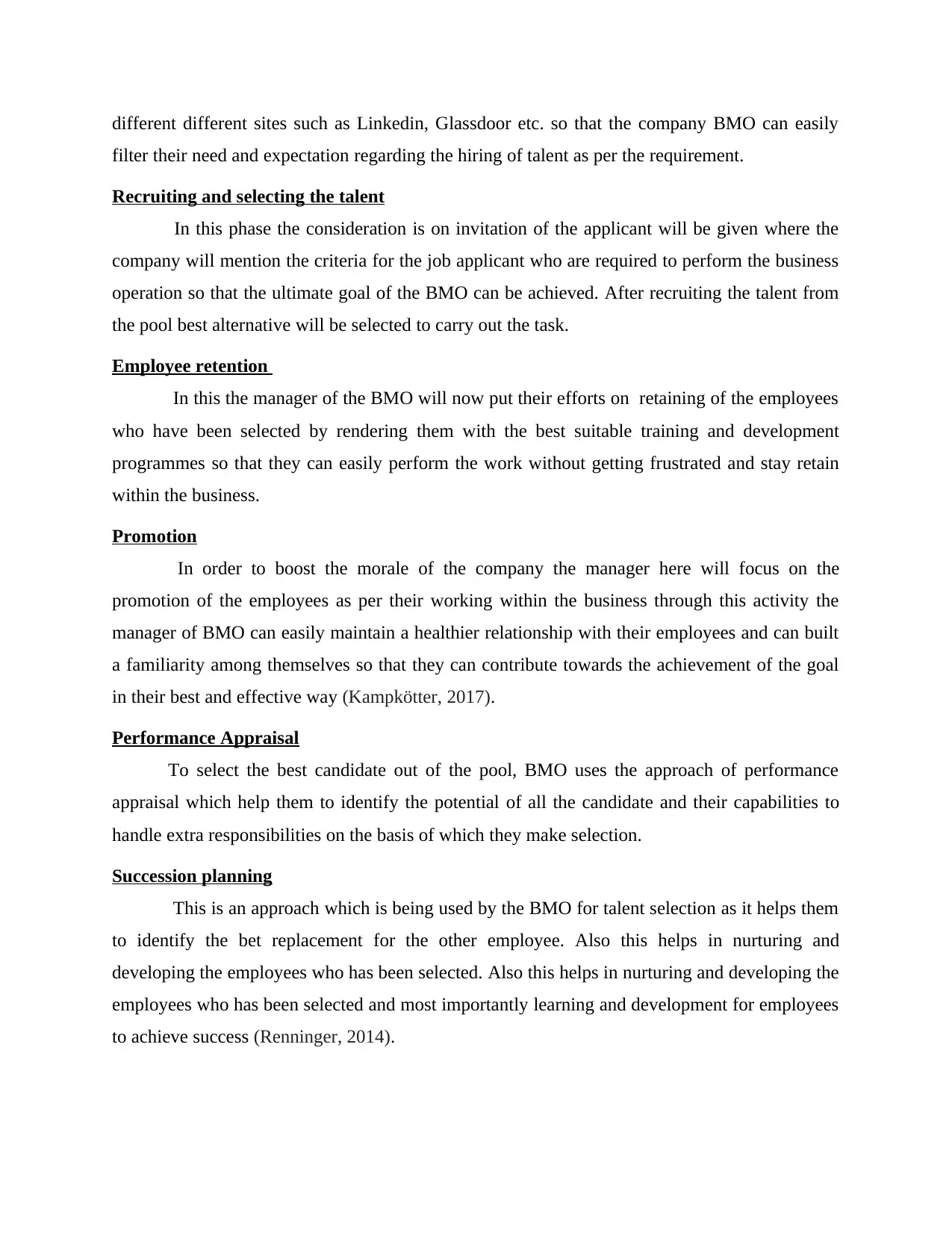
different different sites such as Linkedin, Glassdoor etc. so that the company BMO can easily
filter their need and expectation regarding the hiring of talent as per the requirement.
Recruiting and selecting the talent
In this phase the consideration is on invitation of the applicant will be given where the
company will mention the criteria for the job applicant who are required to perform the business
operation so that the ultimate goal of the BMO can be achieved. After recruiting the talent from
the pool best alternative will be selected to carry out the task.
Employee retention
In this the manager of the BMO will now put their efforts on retaining of the employees
who have been selected by rendering them with the best suitable training and development
programmes so that they can easily perform the work without getting frustrated and stay retain
within the business.
Promotion
In order to boost the morale of the company the manager here will focus on the
promotion of the employees as per their working within the business through this activity the
manager of BMO can easily maintain a healthier relationship with their employees and can built
a familiarity among themselves so that they can contribute towards the achievement of the goal
in their best and effective way (Kampkötter, 2017).
Performance Appraisal
To select the best candidate out of the pool, BMO uses the approach of performance
appraisal which help them to identify the potential of all the candidate and their capabilities to
handle extra responsibilities on the basis of which they make selection.
Succession planning
This is an approach which is being used by the BMO for talent selection as it helps them
to identify the bet replacement for the other employee. Also this helps in nurturing and
developing the employees who has been selected. Also this helps in nurturing and developing the
employees who has been selected and most importantly learning and development for employees
to achieve success (Renninger, 2014).
filter their need and expectation regarding the hiring of talent as per the requirement.
Recruiting and selecting the talent
In this phase the consideration is on invitation of the applicant will be given where the
company will mention the criteria for the job applicant who are required to perform the business
operation so that the ultimate goal of the BMO can be achieved. After recruiting the talent from
the pool best alternative will be selected to carry out the task.
Employee retention
In this the manager of the BMO will now put their efforts on retaining of the employees
who have been selected by rendering them with the best suitable training and development
programmes so that they can easily perform the work without getting frustrated and stay retain
within the business.
Promotion
In order to boost the morale of the company the manager here will focus on the
promotion of the employees as per their working within the business through this activity the
manager of BMO can easily maintain a healthier relationship with their employees and can built
a familiarity among themselves so that they can contribute towards the achievement of the goal
in their best and effective way (Kampkötter, 2017).
Performance Appraisal
To select the best candidate out of the pool, BMO uses the approach of performance
appraisal which help them to identify the potential of all the candidate and their capabilities to
handle extra responsibilities on the basis of which they make selection.
Succession planning
This is an approach which is being used by the BMO for talent selection as it helps them
to identify the bet replacement for the other employee. Also this helps in nurturing and
developing the employees who has been selected. Also this helps in nurturing and developing the
employees who has been selected and most importantly learning and development for employees
to achieve success (Renninger, 2014).
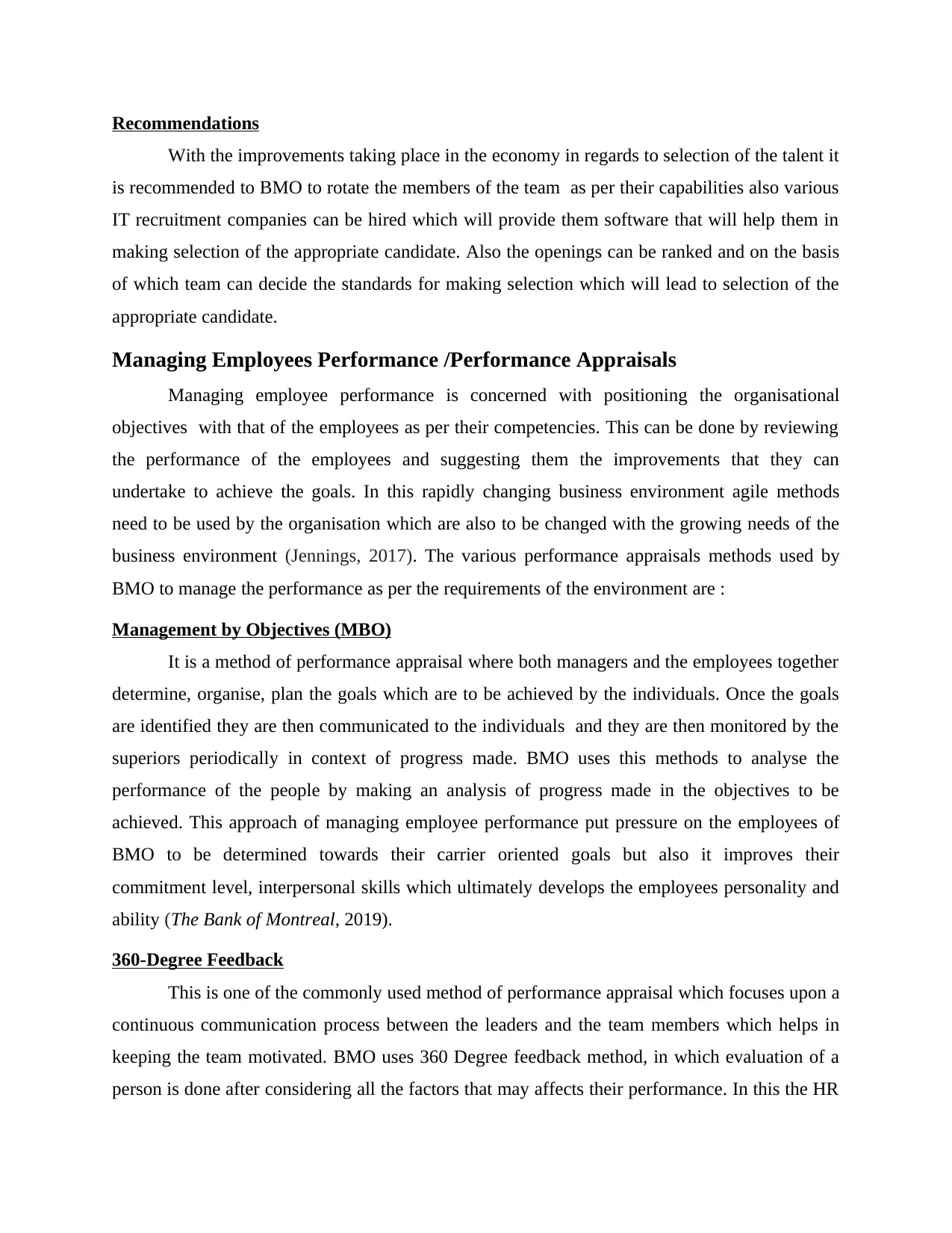
Recommendations
With the improvements taking place in the economy in regards to selection of the talent it
is recommended to BMO to rotate the members of the team as per their capabilities also various
IT recruitment companies can be hired which will provide them software that will help them in
making selection of the appropriate candidate. Also the openings can be ranked and on the basis
of which team can decide the standards for making selection which will lead to selection of the
appropriate candidate.
Managing Employees Performance /Performance Appraisals
Managing employee performance is concerned with positioning the organisational
objectives with that of the employees as per their competencies. This can be done by reviewing
the performance of the employees and suggesting them the improvements that they can
undertake to achieve the goals. In this rapidly changing business environment agile methods
need to be used by the organisation which are also to be changed with the growing needs of the
business environment (Jennings, 2017). The various performance appraisals methods used by
BMO to manage the performance as per the requirements of the environment are :
Management by Objectives (MBO)
It is a method of performance appraisal where both managers and the employees together
determine, organise, plan the goals which are to be achieved by the individuals. Once the goals
are identified they are then communicated to the individuals and they are then monitored by the
superiors periodically in context of progress made. BMO uses this methods to analyse the
performance of the people by making an analysis of progress made in the objectives to be
achieved. This approach of managing employee performance put pressure on the employees of
BMO to be determined towards their carrier oriented goals but also it improves their
commitment level, interpersonal skills which ultimately develops the employees personality and
ability (The Bank of Montreal, 2019).
360-Degree Feedback
This is one of the commonly used method of performance appraisal which focuses upon a
continuous communication process between the leaders and the team members which helps in
keeping the team motivated. BMO uses 360 Degree feedback method, in which evaluation of a
person is done after considering all the factors that may affects their performance. In this the HR
With the improvements taking place in the economy in regards to selection of the talent it
is recommended to BMO to rotate the members of the team as per their capabilities also various
IT recruitment companies can be hired which will provide them software that will help them in
making selection of the appropriate candidate. Also the openings can be ranked and on the basis
of which team can decide the standards for making selection which will lead to selection of the
appropriate candidate.
Managing Employees Performance /Performance Appraisals
Managing employee performance is concerned with positioning the organisational
objectives with that of the employees as per their competencies. This can be done by reviewing
the performance of the employees and suggesting them the improvements that they can
undertake to achieve the goals. In this rapidly changing business environment agile methods
need to be used by the organisation which are also to be changed with the growing needs of the
business environment (Jennings, 2017). The various performance appraisals methods used by
BMO to manage the performance as per the requirements of the environment are :
Management by Objectives (MBO)
It is a method of performance appraisal where both managers and the employees together
determine, organise, plan the goals which are to be achieved by the individuals. Once the goals
are identified they are then communicated to the individuals and they are then monitored by the
superiors periodically in context of progress made. BMO uses this methods to analyse the
performance of the people by making an analysis of progress made in the objectives to be
achieved. This approach of managing employee performance put pressure on the employees of
BMO to be determined towards their carrier oriented goals but also it improves their
commitment level, interpersonal skills which ultimately develops the employees personality and
ability (The Bank of Montreal, 2019).
360-Degree Feedback
This is one of the commonly used method of performance appraisal which focuses upon a
continuous communication process between the leaders and the team members which helps in
keeping the team motivated. BMO uses 360 Degree feedback method, in which evaluation of a
person is done after considering all the factors that may affects their performance. In this the HR
⊘ This is a preview!⊘
Do you want full access?
Subscribe today to unlock all pages.

Trusted by 1+ million students worldwide
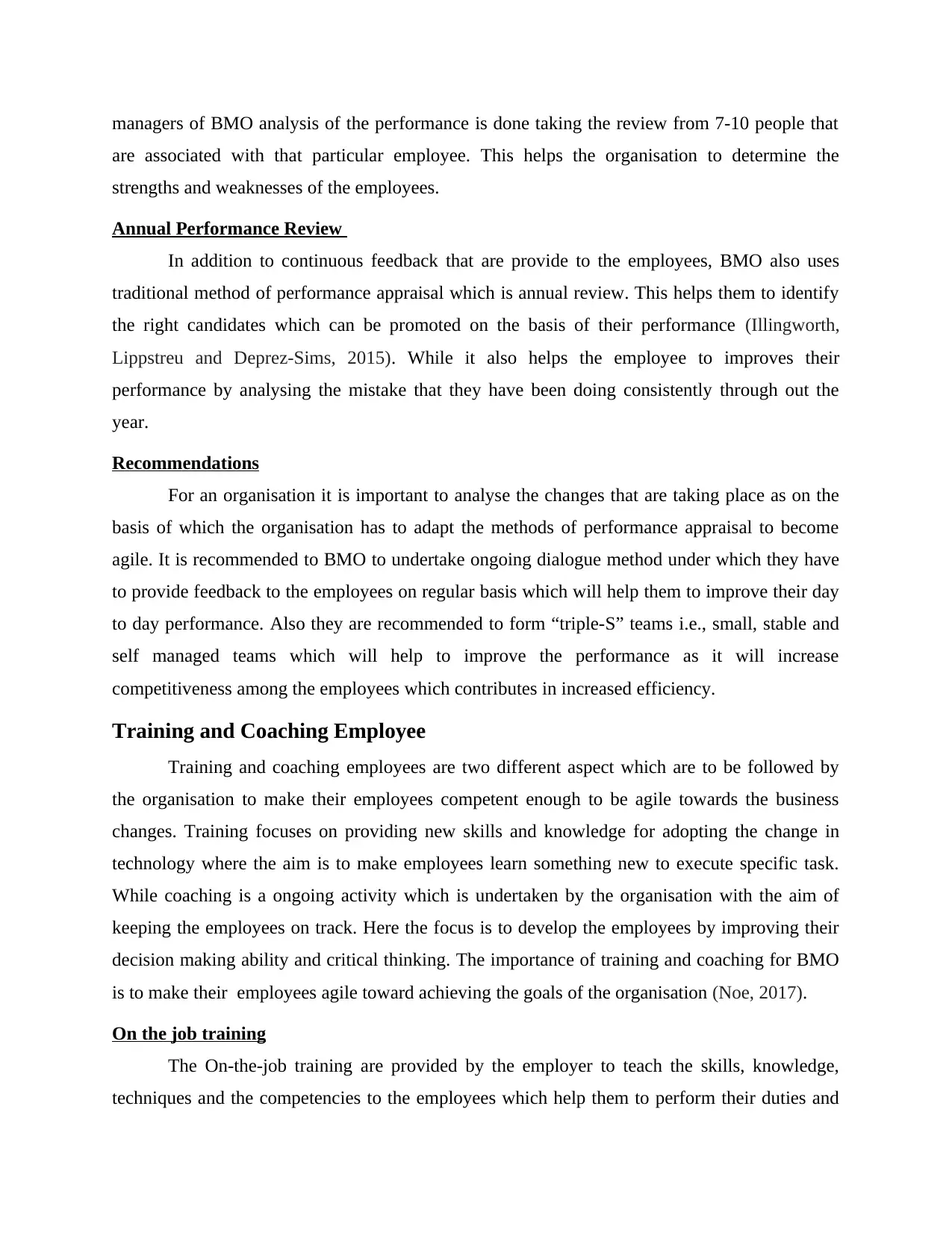
managers of BMO analysis of the performance is done taking the review from 7-10 people that
are associated with that particular employee. This helps the organisation to determine the
strengths and weaknesses of the employees.
Annual Performance Review
In addition to continuous feedback that are provide to the employees, BMO also uses
traditional method of performance appraisal which is annual review. This helps them to identify
the right candidates which can be promoted on the basis of their performance (Illingworth,
Lippstreu and Deprez-Sims, 2015). While it also helps the employee to improves their
performance by analysing the mistake that they have been doing consistently through out the
year.
Recommendations
For an organisation it is important to analyse the changes that are taking place as on the
basis of which the organisation has to adapt the methods of performance appraisal to become
agile. It is recommended to BMO to undertake ongoing dialogue method under which they have
to provide feedback to the employees on regular basis which will help them to improve their day
to day performance. Also they are recommended to form “triple-S” teams i.e., small, stable and
self managed teams which will help to improve the performance as it will increase
competitiveness among the employees which contributes in increased efficiency.
Training and Coaching Employee
Training and coaching employees are two different aspect which are to be followed by
the organisation to make their employees competent enough to be agile towards the business
changes. Training focuses on providing new skills and knowledge for adopting the change in
technology where the aim is to make employees learn something new to execute specific task.
While coaching is a ongoing activity which is undertaken by the organisation with the aim of
keeping the employees on track. Here the focus is to develop the employees by improving their
decision making ability and critical thinking. The importance of training and coaching for BMO
is to make their employees agile toward achieving the goals of the organisation (Noe, 2017).
On the job training
The On-the-job training are provided by the employer to teach the skills, knowledge,
techniques and the competencies to the employees which help them to perform their duties and
are associated with that particular employee. This helps the organisation to determine the
strengths and weaknesses of the employees.
Annual Performance Review
In addition to continuous feedback that are provide to the employees, BMO also uses
traditional method of performance appraisal which is annual review. This helps them to identify
the right candidates which can be promoted on the basis of their performance (Illingworth,
Lippstreu and Deprez-Sims, 2015). While it also helps the employee to improves their
performance by analysing the mistake that they have been doing consistently through out the
year.
Recommendations
For an organisation it is important to analyse the changes that are taking place as on the
basis of which the organisation has to adapt the methods of performance appraisal to become
agile. It is recommended to BMO to undertake ongoing dialogue method under which they have
to provide feedback to the employees on regular basis which will help them to improve their day
to day performance. Also they are recommended to form “triple-S” teams i.e., small, stable and
self managed teams which will help to improve the performance as it will increase
competitiveness among the employees which contributes in increased efficiency.
Training and Coaching Employee
Training and coaching employees are two different aspect which are to be followed by
the organisation to make their employees competent enough to be agile towards the business
changes. Training focuses on providing new skills and knowledge for adopting the change in
technology where the aim is to make employees learn something new to execute specific task.
While coaching is a ongoing activity which is undertaken by the organisation with the aim of
keeping the employees on track. Here the focus is to develop the employees by improving their
decision making ability and critical thinking. The importance of training and coaching for BMO
is to make their employees agile toward achieving the goals of the organisation (Noe, 2017).
On the job training
The On-the-job training are provided by the employer to teach the skills, knowledge,
techniques and the competencies to the employees which help them to perform their duties and
Paraphrase This Document
Need a fresh take? Get an instant paraphrase of this document with our AI Paraphraser
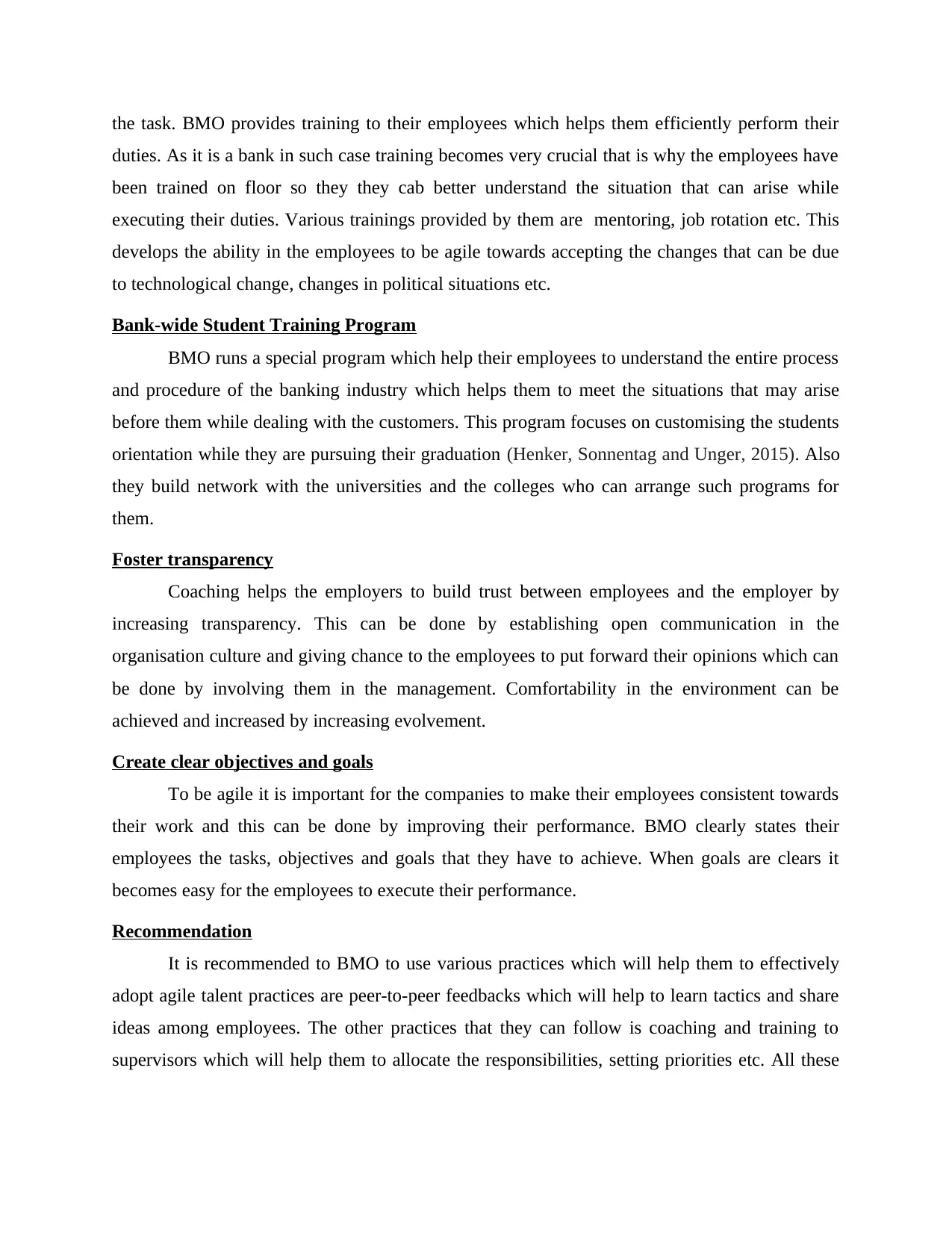
the task. BMO provides training to their employees which helps them efficiently perform their
duties. As it is a bank in such case training becomes very crucial that is why the employees have
been trained on floor so they they cab better understand the situation that can arise while
executing their duties. Various trainings provided by them are mentoring, job rotation etc. This
develops the ability in the employees to be agile towards accepting the changes that can be due
to technological change, changes in political situations etc.
Bank-wide Student Training Program
BMO runs a special program which help their employees to understand the entire process
and procedure of the banking industry which helps them to meet the situations that may arise
before them while dealing with the customers. This program focuses on customising the students
orientation while they are pursuing their graduation (Henker, Sonnentag and Unger, 2015). Also
they build network with the universities and the colleges who can arrange such programs for
them.
Foster transparency
Coaching helps the employers to build trust between employees and the employer by
increasing transparency. This can be done by establishing open communication in the
organisation culture and giving chance to the employees to put forward their opinions which can
be done by involving them in the management. Comfortability in the environment can be
achieved and increased by increasing evolvement.
Create clear objectives and goals
To be agile it is important for the companies to make their employees consistent towards
their work and this can be done by improving their performance. BMO clearly states their
employees the tasks, objectives and goals that they have to achieve. When goals are clears it
becomes easy for the employees to execute their performance.
Recommendation
It is recommended to BMO to use various practices which will help them to effectively
adopt agile talent practices are peer-to-peer feedbacks which will help to learn tactics and share
ideas among employees. The other practices that they can follow is coaching and training to
supervisors which will help them to allocate the responsibilities, setting priorities etc. All these
duties. As it is a bank in such case training becomes very crucial that is why the employees have
been trained on floor so they they cab better understand the situation that can arise while
executing their duties. Various trainings provided by them are mentoring, job rotation etc. This
develops the ability in the employees to be agile towards accepting the changes that can be due
to technological change, changes in political situations etc.
Bank-wide Student Training Program
BMO runs a special program which help their employees to understand the entire process
and procedure of the banking industry which helps them to meet the situations that may arise
before them while dealing with the customers. This program focuses on customising the students
orientation while they are pursuing their graduation (Henker, Sonnentag and Unger, 2015). Also
they build network with the universities and the colleges who can arrange such programs for
them.
Foster transparency
Coaching helps the employers to build trust between employees and the employer by
increasing transparency. This can be done by establishing open communication in the
organisation culture and giving chance to the employees to put forward their opinions which can
be done by involving them in the management. Comfortability in the environment can be
achieved and increased by increasing evolvement.
Create clear objectives and goals
To be agile it is important for the companies to make their employees consistent towards
their work and this can be done by improving their performance. BMO clearly states their
employees the tasks, objectives and goals that they have to achieve. When goals are clears it
becomes easy for the employees to execute their performance.
Recommendation
It is recommended to BMO to use various practices which will help them to effectively
adopt agile talent practices are peer-to-peer feedbacks which will help to learn tactics and share
ideas among employees. The other practices that they can follow is coaching and training to
supervisors which will help them to allocate the responsibilities, setting priorities etc. All these
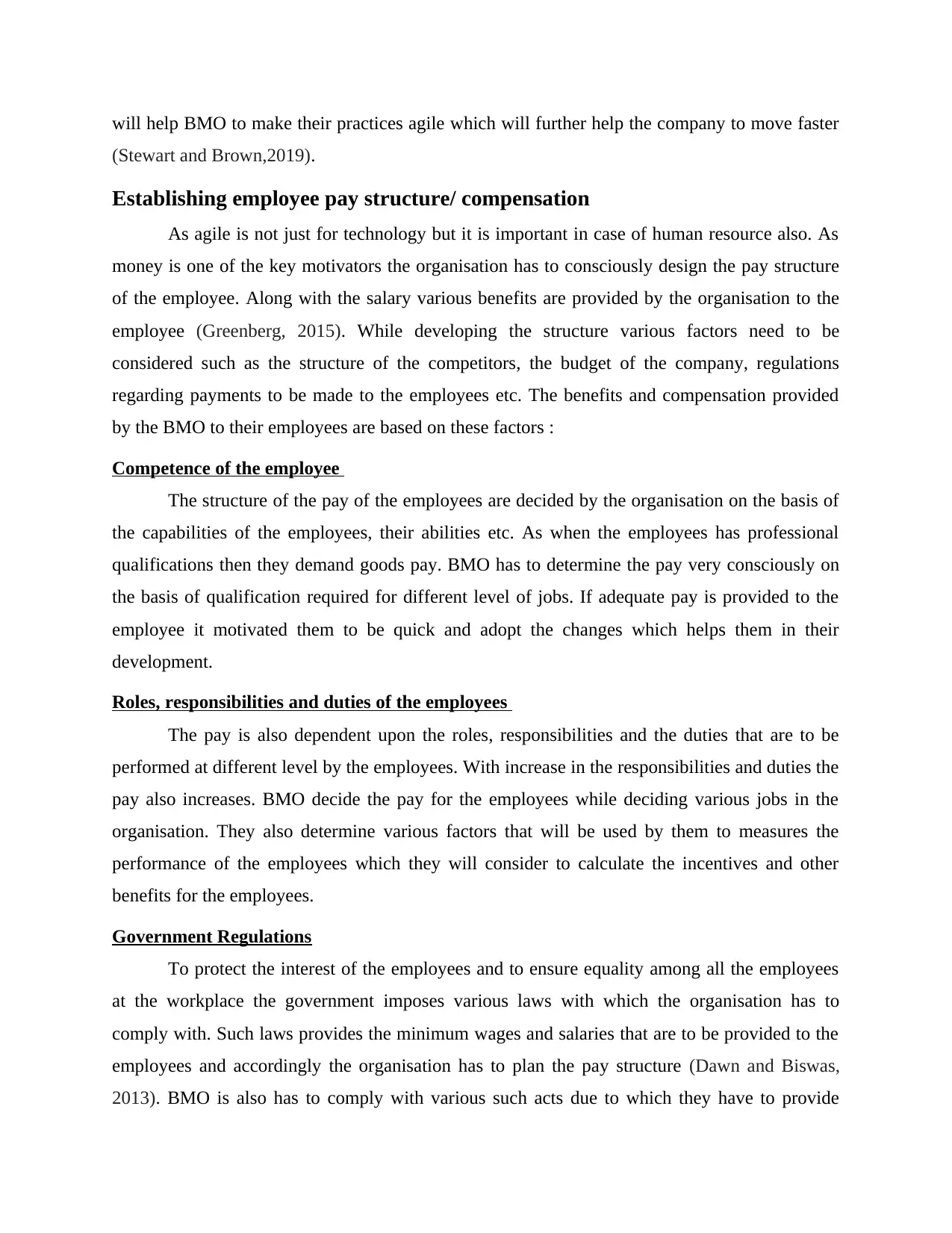
will help BMO to make their practices agile which will further help the company to move faster
(Stewart and Brown,2019).
Establishing employee pay structure/ compensation
As agile is not just for technology but it is important in case of human resource also. As
money is one of the key motivators the organisation has to consciously design the pay structure
of the employee. Along with the salary various benefits are provided by the organisation to the
employee (Greenberg, 2015). While developing the structure various factors need to be
considered such as the structure of the competitors, the budget of the company, regulations
regarding payments to be made to the employees etc. The benefits and compensation provided
by the BMO to their employees are based on these factors :
Competence of the employee
The structure of the pay of the employees are decided by the organisation on the basis of
the capabilities of the employees, their abilities etc. As when the employees has professional
qualifications then they demand goods pay. BMO has to determine the pay very consciously on
the basis of qualification required for different level of jobs. If adequate pay is provided to the
employee it motivated them to be quick and adopt the changes which helps them in their
development.
Roles, responsibilities and duties of the employees
The pay is also dependent upon the roles, responsibilities and the duties that are to be
performed at different level by the employees. With increase in the responsibilities and duties the
pay also increases. BMO decide the pay for the employees while deciding various jobs in the
organisation. They also determine various factors that will be used by them to measures the
performance of the employees which they will consider to calculate the incentives and other
benefits for the employees.
Government Regulations
To protect the interest of the employees and to ensure equality among all the employees
at the workplace the government imposes various laws with which the organisation has to
comply with. Such laws provides the minimum wages and salaries that are to be provided to the
employees and accordingly the organisation has to plan the pay structure (Dawn and Biswas,
2013). BMO is also has to comply with various such acts due to which they have to provide
(Stewart and Brown,2019).
Establishing employee pay structure/ compensation
As agile is not just for technology but it is important in case of human resource also. As
money is one of the key motivators the organisation has to consciously design the pay structure
of the employee. Along with the salary various benefits are provided by the organisation to the
employee (Greenberg, 2015). While developing the structure various factors need to be
considered such as the structure of the competitors, the budget of the company, regulations
regarding payments to be made to the employees etc. The benefits and compensation provided
by the BMO to their employees are based on these factors :
Competence of the employee
The structure of the pay of the employees are decided by the organisation on the basis of
the capabilities of the employees, their abilities etc. As when the employees has professional
qualifications then they demand goods pay. BMO has to determine the pay very consciously on
the basis of qualification required for different level of jobs. If adequate pay is provided to the
employee it motivated them to be quick and adopt the changes which helps them in their
development.
Roles, responsibilities and duties of the employees
The pay is also dependent upon the roles, responsibilities and the duties that are to be
performed at different level by the employees. With increase in the responsibilities and duties the
pay also increases. BMO decide the pay for the employees while deciding various jobs in the
organisation. They also determine various factors that will be used by them to measures the
performance of the employees which they will consider to calculate the incentives and other
benefits for the employees.
Government Regulations
To protect the interest of the employees and to ensure equality among all the employees
at the workplace the government imposes various laws with which the organisation has to
comply with. Such laws provides the minimum wages and salaries that are to be provided to the
employees and accordingly the organisation has to plan the pay structure (Dawn and Biswas,
2013). BMO is also has to comply with various such acts due to which they have to provide
⊘ This is a preview!⊘
Do you want full access?
Subscribe today to unlock all pages.

Trusted by 1+ million students worldwide
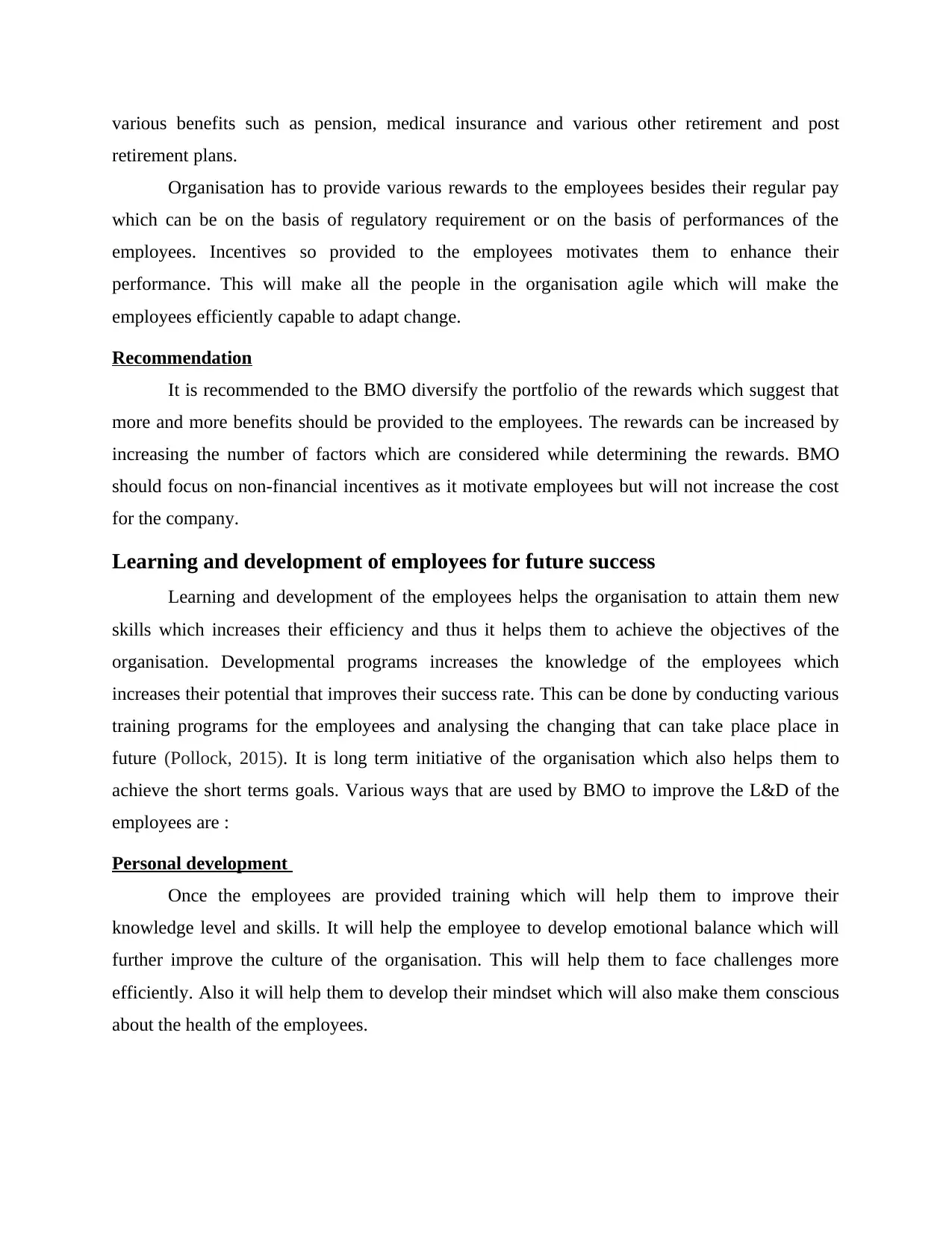
various benefits such as pension, medical insurance and various other retirement and post
retirement plans.
Organisation has to provide various rewards to the employees besides their regular pay
which can be on the basis of regulatory requirement or on the basis of performances of the
employees. Incentives so provided to the employees motivates them to enhance their
performance. This will make all the people in the organisation agile which will make the
employees efficiently capable to adapt change.
Recommendation
It is recommended to the BMO diversify the portfolio of the rewards which suggest that
more and more benefits should be provided to the employees. The rewards can be increased by
increasing the number of factors which are considered while determining the rewards. BMO
should focus on non-financial incentives as it motivate employees but will not increase the cost
for the company.
Learning and development of employees for future success
Learning and development of the employees helps the organisation to attain them new
skills which increases their efficiency and thus it helps them to achieve the objectives of the
organisation. Developmental programs increases the knowledge of the employees which
increases their potential that improves their success rate. This can be done by conducting various
training programs for the employees and analysing the changing that can take place place in
future (Pollock, 2015). It is long term initiative of the organisation which also helps them to
achieve the short terms goals. Various ways that are used by BMO to improve the L&D of the
employees are :
Personal development
Once the employees are provided training which will help them to improve their
knowledge level and skills. It will help the employee to develop emotional balance which will
further improve the culture of the organisation. This will help them to face challenges more
efficiently. Also it will help them to develop their mindset which will also make them conscious
about the health of the employees.
retirement plans.
Organisation has to provide various rewards to the employees besides their regular pay
which can be on the basis of regulatory requirement or on the basis of performances of the
employees. Incentives so provided to the employees motivates them to enhance their
performance. This will make all the people in the organisation agile which will make the
employees efficiently capable to adapt change.
Recommendation
It is recommended to the BMO diversify the portfolio of the rewards which suggest that
more and more benefits should be provided to the employees. The rewards can be increased by
increasing the number of factors which are considered while determining the rewards. BMO
should focus on non-financial incentives as it motivate employees but will not increase the cost
for the company.
Learning and development of employees for future success
Learning and development of the employees helps the organisation to attain them new
skills which increases their efficiency and thus it helps them to achieve the objectives of the
organisation. Developmental programs increases the knowledge of the employees which
increases their potential that improves their success rate. This can be done by conducting various
training programs for the employees and analysing the changing that can take place place in
future (Pollock, 2015). It is long term initiative of the organisation which also helps them to
achieve the short terms goals. Various ways that are used by BMO to improve the L&D of the
employees are :
Personal development
Once the employees are provided training which will help them to improve their
knowledge level and skills. It will help the employee to develop emotional balance which will
further improve the culture of the organisation. This will help them to face challenges more
efficiently. Also it will help them to develop their mindset which will also make them conscious
about the health of the employees.
Paraphrase This Document
Need a fresh take? Get an instant paraphrase of this document with our AI Paraphraser
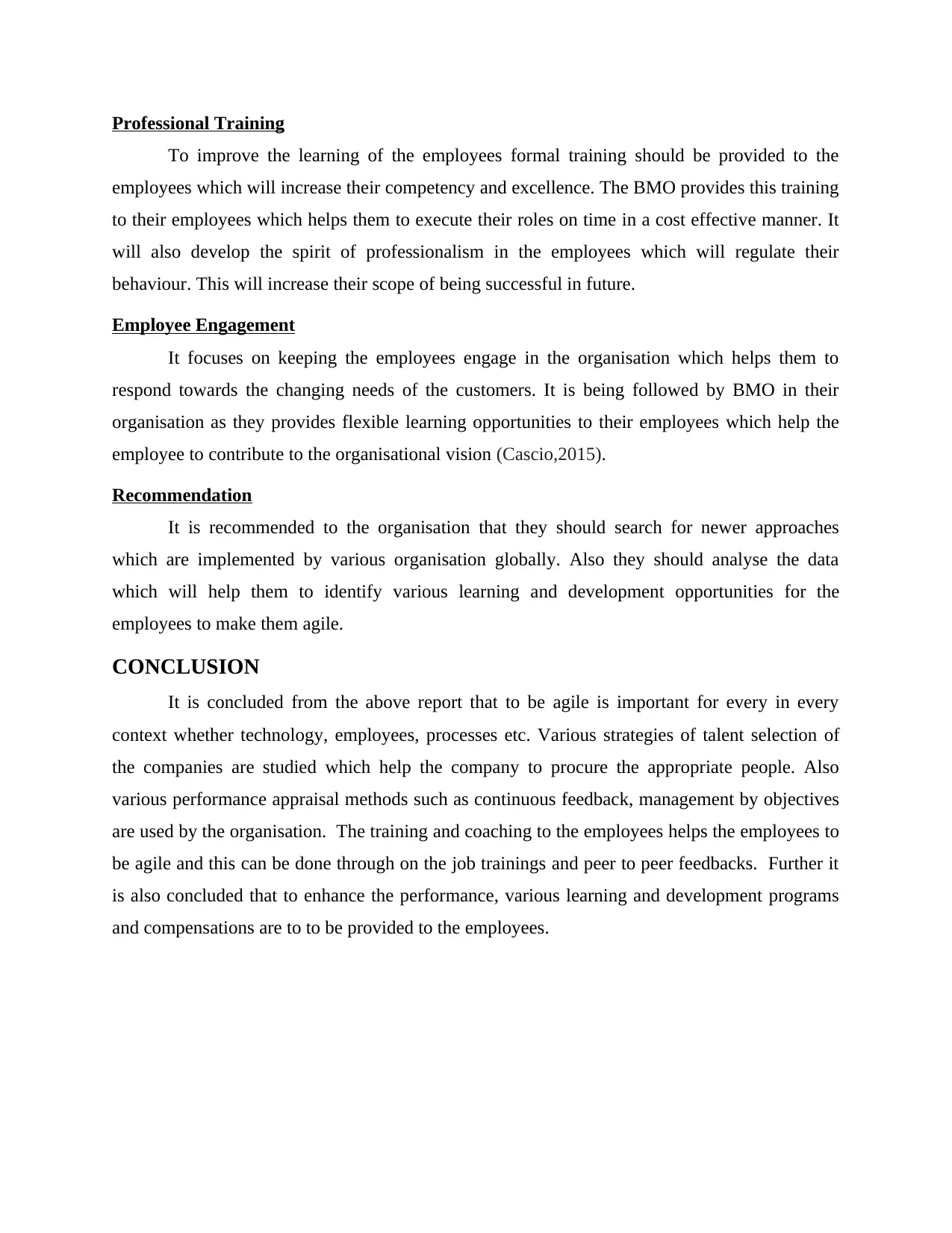
Professional Training
To improve the learning of the employees formal training should be provided to the
employees which will increase their competency and excellence. The BMO provides this training
to their employees which helps them to execute their roles on time in a cost effective manner. It
will also develop the spirit of professionalism in the employees which will regulate their
behaviour. This will increase their scope of being successful in future.
Employee Engagement
It focuses on keeping the employees engage in the organisation which helps them to
respond towards the changing needs of the customers. It is being followed by BMO in their
organisation as they provides flexible learning opportunities to their employees which help the
employee to contribute to the organisational vision (Cascio,2015).
Recommendation
It is recommended to the organisation that they should search for newer approaches
which are implemented by various organisation globally. Also they should analyse the data
which will help them to identify various learning and development opportunities for the
employees to make them agile.
CONCLUSION
It is concluded from the above report that to be agile is important for every in every
context whether technology, employees, processes etc. Various strategies of talent selection of
the companies are studied which help the company to procure the appropriate people. Also
various performance appraisal methods such as continuous feedback, management by objectives
are used by the organisation. The training and coaching to the employees helps the employees to
be agile and this can be done through on the job trainings and peer to peer feedbacks. Further it
is also concluded that to enhance the performance, various learning and development programs
and compensations are to to be provided to the employees.
To improve the learning of the employees formal training should be provided to the
employees which will increase their competency and excellence. The BMO provides this training
to their employees which helps them to execute their roles on time in a cost effective manner. It
will also develop the spirit of professionalism in the employees which will regulate their
behaviour. This will increase their scope of being successful in future.
Employee Engagement
It focuses on keeping the employees engage in the organisation which helps them to
respond towards the changing needs of the customers. It is being followed by BMO in their
organisation as they provides flexible learning opportunities to their employees which help the
employee to contribute to the organisational vision (Cascio,2015).
Recommendation
It is recommended to the organisation that they should search for newer approaches
which are implemented by various organisation globally. Also they should analyse the data
which will help them to identify various learning and development opportunities for the
employees to make them agile.
CONCLUSION
It is concluded from the above report that to be agile is important for every in every
context whether technology, employees, processes etc. Various strategies of talent selection of
the companies are studied which help the company to procure the appropriate people. Also
various performance appraisal methods such as continuous feedback, management by objectives
are used by the organisation. The training and coaching to the employees helps the employees to
be agile and this can be done through on the job trainings and peer to peer feedbacks. Further it
is also concluded that to enhance the performance, various learning and development programs
and compensations are to to be provided to the employees.
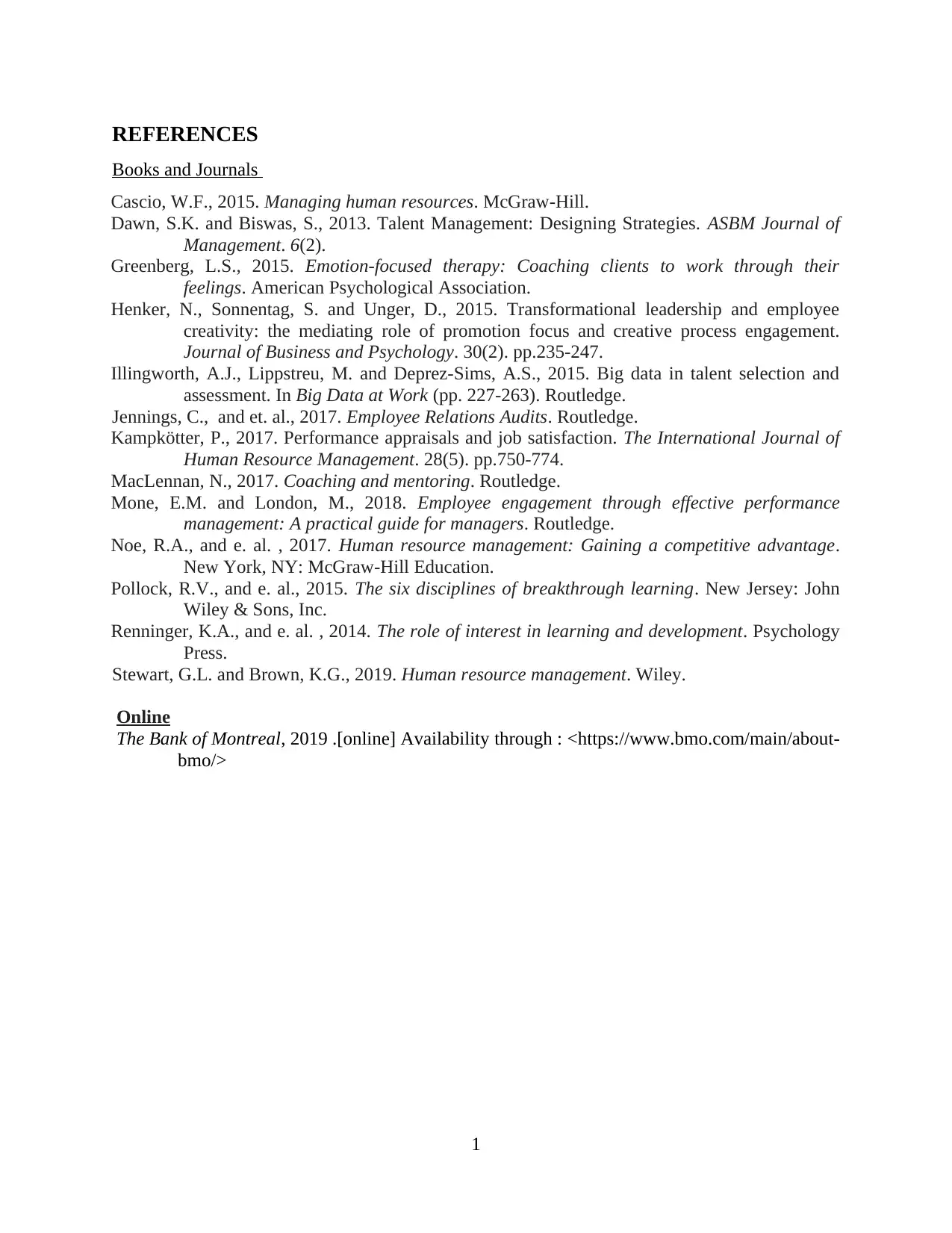
REFERENCES
Books and Journals
Cascio, W.F., 2015. Managing human resources. McGraw-Hill.
Dawn, S.K. and Biswas, S., 2013. Talent Management: Designing Strategies. ASBM Journal of
Management. 6(2).
Greenberg, L.S., 2015. Emotion-focused therapy: Coaching clients to work through their
feelings. American Psychological Association.
Henker, N., Sonnentag, S. and Unger, D., 2015. Transformational leadership and employee
creativity: the mediating role of promotion focus and creative process engagement.
Journal of Business and Psychology. 30(2). pp.235-247.
Illingworth, A.J., Lippstreu, M. and Deprez-Sims, A.S., 2015. Big data in talent selection and
assessment. In Big Data at Work (pp. 227-263). Routledge.
Jennings, C., and et. al., 2017. Employee Relations Audits. Routledge.
Kampkötter, P., 2017. Performance appraisals and job satisfaction. The International Journal of
Human Resource Management. 28(5). pp.750-774.
MacLennan, N., 2017. Coaching and mentoring. Routledge.
Mone, E.M. and London, M., 2018. Employee engagement through effective performance
management: A practical guide for managers. Routledge.
Noe, R.A., and e. al. , 2017. Human resource management: Gaining a competitive advantage.
New York, NY: McGraw-Hill Education.
Pollock, R.V., and e. al., 2015. The six disciplines of breakthrough learning. New Jersey: John
Wiley & Sons, Inc.
Renninger, K.A., and e. al. , 2014. The role of interest in learning and development. Psychology
Press.
Stewart, G.L. and Brown, K.G., 2019. Human resource management. Wiley.
Online
The Bank of Montreal, 2019 .[online] Availability through : <https://www.bmo.com/main/about-
bmo/>
1
Books and Journals
Cascio, W.F., 2015. Managing human resources. McGraw-Hill.
Dawn, S.K. and Biswas, S., 2013. Talent Management: Designing Strategies. ASBM Journal of
Management. 6(2).
Greenberg, L.S., 2015. Emotion-focused therapy: Coaching clients to work through their
feelings. American Psychological Association.
Henker, N., Sonnentag, S. and Unger, D., 2015. Transformational leadership and employee
creativity: the mediating role of promotion focus and creative process engagement.
Journal of Business and Psychology. 30(2). pp.235-247.
Illingworth, A.J., Lippstreu, M. and Deprez-Sims, A.S., 2015. Big data in talent selection and
assessment. In Big Data at Work (pp. 227-263). Routledge.
Jennings, C., and et. al., 2017. Employee Relations Audits. Routledge.
Kampkötter, P., 2017. Performance appraisals and job satisfaction. The International Journal of
Human Resource Management. 28(5). pp.750-774.
MacLennan, N., 2017. Coaching and mentoring. Routledge.
Mone, E.M. and London, M., 2018. Employee engagement through effective performance
management: A practical guide for managers. Routledge.
Noe, R.A., and e. al. , 2017. Human resource management: Gaining a competitive advantage.
New York, NY: McGraw-Hill Education.
Pollock, R.V., and e. al., 2015. The six disciplines of breakthrough learning. New Jersey: John
Wiley & Sons, Inc.
Renninger, K.A., and e. al. , 2014. The role of interest in learning and development. Psychology
Press.
Stewart, G.L. and Brown, K.G., 2019. Human resource management. Wiley.
Online
The Bank of Montreal, 2019 .[online] Availability through : <https://www.bmo.com/main/about-
bmo/>
1
⊘ This is a preview!⊘
Do you want full access?
Subscribe today to unlock all pages.

Trusted by 1+ million students worldwide
1 out of 12
Related Documents
Your All-in-One AI-Powered Toolkit for Academic Success.
+13062052269
info@desklib.com
Available 24*7 on WhatsApp / Email
![[object Object]](/_next/static/media/star-bottom.7253800d.svg)
Unlock your academic potential
Copyright © 2020–2025 A2Z Services. All Rights Reserved. Developed and managed by ZUCOL.




